Individual vs. Community: Economic Assessment of Energy Management Systems under Different Regulatory Frameworks
Abstract
1. Introduction
1.1. Context
1.2. Literature Survey
1.3. Gap Identification and Main Contributions
- -
- Identification and definition of key regulatory frameworks that may impact in the finances of the users of a microgrid.
- -
- Definition of the boundaries of a what-if analysis addressed to quantify whether:
- a)
- The economic results of a single prosumer under the same regulatory scheme might be affected by the consumption profiles.
- b)
- The economic results of an individual or collective entity might be affected by the regulatory scheme under application.
- -
- Examination of the findings and provision of a clear insight into the pros and cons of an energy community versus a private facility. These insights derive from the discussion of the effects of the regulatory frameworks and consumption profiles on the results.
1.4. Methodology
2. Microgrid Model and Mathematical Program
2.1. Physical Model
2.2. Economic Model
2.2.1. Operation and Maintenance Costs
2.2.2. Consumers’ Energy Bill Structure
2.2.3. Regulatory Structures Used to Promote DER Facilities
2.3. Objective Function
2.4. Differences between Individual and Community Formulations
3. Case Studies
3.1. What-If Analysis and Scenarios Definition
3.2. Generation Potential
3.3. Energy Consumption
3.4. Electricity Prices
3.5. Regulatory Scenarios
3.5.1. FiT Scheme
3.5.2. Net Metering Schemes
3.5.3. Self-Consumption Schemes
3.6. Data Summary
4. Results
4.1. Economic Results of the Energy Community
4.2. Economic Results of a Single Prosumer
4.2.1. Single Prosumer with ESS under Different Types of Energy Consumption Profiles
4.2.2. Single Prosumer without ESS under Different Types of Energy Consumption Profiles
5. Individual Prosumer vs. Energy Community: Discussion
- -
- Any of the individual generators can satisfy the energy needs of any other member of the community. For instance, solar panels on an empty household can supply energy to the neighborhood instead of selling the energy to the generally more beneficial grid.
- -
- The electrical overall demand curve is flatter. Even though each household has its own peaks of consumption, the peaks do not occur simultaneously. In consequence, the aggregate consumption is smoother. This reduces the energy storage needs, because the individual peaks are produced typically in the morning and in the night, moments where solar energy is unavailable.
- -
- Generators in different households can have diverse orientations. PV panels tilted to the east will generate more energy during the morning while the ones tilted to the west will provide more energy during the last hours of the day. This leads to the generation curve being more evenly distributed across the hours of the day. Therefore, the self-consumption rate, meaning the percentage of demand which is covered by the self-consumption facility, is higher.
6. Conclusions
- -
- It is proven that FiT, currently the most employed regulatory framework in the EU, is not the best alternative to foster DER facilities. In addition, while FiT efficacy to promote large-scale, private-owned facilities is undeniable, it encourages massive energy dumping, which can be detrimental for the grid stability and the economics of the system operator. If regulation is to change the energy paradigm into a decentralized system, policy makers should avoid the use of fixed tariffs for the energy sale. These tariffs are better suited for large and centralized power plants.
- -
- ESS should be promoted, especially in the collective case, where the initial investment can be jointly assumed among all members of the community. However, policy makers who opt for a FiT scheme should be wary about promoting ESS. The reason is that if the tariff is high enough, ESS can be used for energy arbitraging, meaning that ESS will be employed to purchase energy at the lowest price in the day and then sell it to the FiT rate. This is not a desirable effect of ESS promotion and can be detrimental both for the grid finances and the community’s ethics.
- -
- Of all the schemes analyzed, net metering is the one which shows the most advantages at DER promotion. However, policy makers should not blindly opt for net metering. Even daily net metering is unable to improve the economic results of individuals that already enjoy a high level of self-sufficiency by introducing them in a community. For a DER-fostering mechanism to have effect, a rewarding scheme based on each prosumer’s habits of consumption should be taken into consideration. This will, in turn, encourage investments in demand-side management, improving energy efficiency and economics.
- -
- Type-A self-consumption has been proved to be ineffective at promoting renewable energy facilities, both collective and privately owned. If policy makers determine that grid charges are to be introduced, a rewarding mechanism for the surplus energy must be established as well (type-B self-consumption).
Author Contributions
Funding
Institutional Review Board Statement
Informed Consent Statement
Conflicts of Interest
Nomenclature
| General | |
| CEL | Cost of energy loss |
| DER | Distributed energy resources |
| ESS | Energy Storage System |
| FiT | Feed-in-Tariff scheme |
| HNM/DNM | Hourly/Daily Net Metering |
| MILP | Mixed Integer Linear Program |
| O&M | Operation and Maintenance |
| RES | Renewable Energy Sources |
| SFC_A/SFC_B | Self-consumption scheme types A/B |
| Mathematical program | |
| Binary_St | Binary variable that indicates the state of the battery (dimensionless) |
| C.GAU | Total operation and maintenance costs [€] |
| CFG/CFG.AU | Fixed operation and maintenance costs term [€/kW] and overall [€] |
| CVG/CVG.AU | Variable operation and maintenance costs term [€/kWh] and overall [€] |
| CFS/CF.ST | Fixed O&M costs term [€/kW] and overall [€] for the ESS |
| CVS/CV.ST | Variable O&M costs term [€/kWh] and overall [€] for the ESS |
| CHSA | Auxiliary services consumption [kWh] |
| EBill RS/CS | Final price of the electricity bill for the regulatory scheme (RS) and for the conventional system (CS) [€] |
| EG | Energy supplied by the electrical grid [kWh] |
| EHC | Energy consumption [kWh] |
| EnergyCost | Cost of electricity without charges and taxes [€] |
| ENG | Tax coefficient over the amount of sold energy [€/kWh] |
| EP | Equivalent energy price [€/kWh] |
| ER | Energy produced by RES [kWh] |
| ERMax | Maximum potential of RES [kW] |
| ESC/ESD | Energy charged / discharged by the ESS [kWh] |
| ESCmax/ESDmax | Maximum energy that the battery is able to charge /discharge in an hour [kWh] |
| EtG | Energy exported to the electrical grid [kWh] |
| IMP.GE | Taxes related to the energy sale [€] |
| ING | Tax coefficient over the price of sold energy (dimensionless) |
| Nbat Obj. f | Efficiency of the battery (dimensionless) Value of the objective function [€] |
| Pc and Ec | Power/Energy charges of the self-consumption scheme [€/kW] and [€/kWh] |
| PCon | Contracted power [kW] |
| P_FiT | Feed-in-tariff rate [€/kWh] |
| Pmd | Day-ahead electricity market price [€/kWh] |
| S | Stored energy in the ESS [kWh] |
| S0 | Initial charge of the battery [kWh] |
| Smax | Maximum capacity of the battery [kWh] |
| SoC | State of Charge of the ESS (dimensionless) |
| SoC min/max | Minimum and maximum State of Charge of the ESS (dimensionless) |
| TaxCoef | Tax related to energy purchase (dimensionless) |
| Tp/T.FP | Power term of the access tariff [€/kW]/Overall cost of the power term [€] |
| Te/T.FE | Energy term of the access tariff [€/kWh]/Overall cost of the energy term [€] |
| X_Y | Energy flow from X to Y. For example, EG_EHC is the energy flow from grid to consumption |
References
- European Commission. 2030 Climate & Energy Framework. Available online: https://ec.europa.eu/clima/policies/strategies/2030 (accessed on 30 March 2020).
- Gangale, F.; Vasiljevska, J.; Covrig, F.; Mengolini, A.; Fulli, G. Smart Grid Projects Outlook 2017: Facts, Figures and Trends in Europe; Publications Office of the European Union: Luxembourg, 2017; pp. 31–32. [Google Scholar] [CrossRef]
- International Renewable Energy Agency. The Post-Covid Recovery. An Agenda for Resilience, Development and Equality. Available online: https://www.irena.org/-/media/Files/IRENA/Agency/Publication/2020/Jun/IRENA_Post-COVID_Recovery_2020.pdf (accessed on 3 July 2020).
- European Commission. Study on “Residential Prosumers in the European Energy Union”. Available online: https://ec.europa.eu/commission/sites/beta-political/files/study-residential-prosumers-energy-union_en.pdf (accessed on 14 April 2020).
- Koirala, B.P.; Koliou, E.; Friege, J.; Hakvoort, R.A.; Herder, P.M. Energetic Communities for Community Energy: A Review of Key Issues and Trends Shaping Integrated Community Energy Systems. Renew. Sustain. Energy Rev. 2016, 56, 722–744. [Google Scholar] [CrossRef]
- Amaral-Lopes, R.; Martins, J.; Aelenei, D.; Pantoja-Lima, C. A cooperative net zero energy community to improve load matching. Renew. Energy 2016, 93, 1–13. [Google Scholar] [CrossRef]
- Tomc, M.E.; Vassallo, A.M. The effect of individual and communal electricity generation, consumption and storage on urban Community Renewable Energy Networks (CREN): An Australian case study. Int. J. Sustain. Energy Plan. Manag. 2016, 11, 15–32. [Google Scholar] [CrossRef]
- Süsser, D.; Döring, M.; Ratter, B. Harvesting energy: Place and local entrepreneurship in community-based renewable energy transition. Energy Policy 2017, 101, 332–341. [Google Scholar] [CrossRef]
- Braito, M.; Flint, C.; Muhar, A.; Penker, M.; Vogel, S. Individual and collective socio-psychological patterns of photovoltaic investment under diverging policy regimes of Austria and Italy. Energy Policy 2017, 109, 141–153. [Google Scholar] [CrossRef]
- Kalkbrenner, B.; Roosen, J. Citizens’ willingness to participate in local renewable energy projects: The role of community and trust in Germany. Energy Res. Soc. Sci. 2016, 13, 60–70. [Google Scholar] [CrossRef]
- Vuichard, P.; Stauch, A.; Dällenbach, N. Individual or collective? Community investment, local taxes, and the social acceptance of wind energy in Switzerland. Energy Res. Soc. Sci. 2019, 58, 101275. [Google Scholar] [CrossRef]
- Mey, F.; Diesendorf, M.; MacGill, I. Can local government play a greater role for community renewable energy? A case study from Australia. Energy Res. Soc. Sci. 2016, 21, 33–43. [Google Scholar] [CrossRef]
- Hanna, R.; Ghonima, M.; Kleissl, J.; Tynan, G.; Victor, D. Evaluating business models for microgrids: Interactions of technology and policy. Energy Policy 2017, 103, 47–61. [Google Scholar] [CrossRef]
- Cornélusse, B.; Savelli, I.; Paoletti, S.; Giannitrapani, A.; Vicino, A. A community microgrid architecture with an internal local market. Appl. Energy 2019, 242, 547–560. [Google Scholar] [CrossRef]
- Mengelkamp, E.; Gärttner, J.; Rock, K.; Kessler, S.; Orsini, L. Designing microgrid energy markets. A case study: The Brooklyn Microgrid. Appl. Energy 2018, 210, 870–880. [Google Scholar] [CrossRef]
- Liu, Y.; Zuo, K.; Liu, A.; Liu, J.; Kennedy, J.M. Dynamic pricing for decentralized energy trading in micro-grids. Appl. Energy 2018, 228, 689–699. [Google Scholar] [CrossRef]
- Liu, X.; Wang, S.; Sun, J. Energy management for community energy network with CHP based on cooperative game. Energies 2018, 11, 1066. [Google Scholar] [CrossRef]
- Jia, L.; Tong, L. Renewables and storage in distribution systems: Centralized vs. decentralized integration. IEEE J. Sel. Areas Commun. 2016, 34, 665–674. [Google Scholar] [CrossRef]
- Prete, C.L.; Hobbs, B. A cooperative game theoretic analysis of incentives for microgrids in regulated electricity markets. Appl. Energy 2016, 169, 524–541. [Google Scholar] [CrossRef]
- Chen, W.; Zeng, Y.; Xu, C. Energy storage subsidy estimation for microgrid: A real option game-theoretic approach. Appl. Energy 2019, 239, 373–382. [Google Scholar] [CrossRef]
- Roberts, M.B.; Bruce, A.; MacGill, I. Impact of shared battery energy storage systems on photovoltaic self-consumption and electricity bills in apartment buildings. Appl. Energy 2019, 245, 78–95. [Google Scholar] [CrossRef]
- Long, C.; Wu, J.; Zhou, Y.; Jenkins, N. Peer-to-peer energy sharing through a two-stage aggregated battery control in a community Microgrid. Appl. Energy 2018, 226, 262–276. [Google Scholar] [CrossRef]
- Lüth, A.; Zepter, J.M.; Crespo-del-Granado, P.; Egging, R. Local electricity market designs for peer-to-peer trading: The role of battery flexibility. Appl. Energy 2018, 229, 1233–1243. [Google Scholar] [CrossRef]
- Zepter, J.M.; Lüth, A.; Crespo-del-Granado, P.; Egging, R. Prosumer integration in wholesale electricity markets: Synergies of peer-to-peer trade and residential storage. Energy Build. 2019, 184, 163–176. [Google Scholar] [CrossRef]
- Qi, W.; Shen, B.; Zhang, H.; Shen, Z.M. Sharing demand-side energy resources—A conceptual design. Energy 2017, 135, 455–465. [Google Scholar] [CrossRef]
- Barbour, E.; Parra, D.; Awwad, Z.; González, M.C. Community Energy Storage: A smart choice for the smart grid? Appl. Energy 2018, 212, 489–497. [Google Scholar] [CrossRef]
- Van der Stelt, S.; AlSkaif, T.; van Sark, W. Techno-economic analysis of household and community energy storage for residential prosumers with smart appliances. Appl. Energy 2018, 209, 266–276. [Google Scholar] [CrossRef]
- Quoilin, S.; Kavvadias, K.; Mercier, A.; Pappone, I.; Zucker, A. Quantifying self-consumption linked to solar home battery systems: Statistical analysis and economic assessment. Appl. Energy 2016, 182, 58–67. [Google Scholar] [CrossRef]
- Müller, S.C.; Welpe, I.M. Sharing electricity storage at the community level: An empirical analysis of potential business models and barriers. Energy Policy 2018, 118, 492–503. [Google Scholar] [CrossRef]
- Campos, I.; Pontes Luz, G.; Marín-González, E.; Gährs, S.; Hall, S.; Holstenkam, L. Regulatory challenges and opportunities for collective renewable energy prosumers in the EU. Energy Policy 2019, 138, 111212. [Google Scholar] [CrossRef]
- De la Hoz, J.; Alonso, À.; Coronas, S.; Martín, H.; Matas, J. Impact of Different Regulatory Structures on the Management of Energy Communities. Energies 2020, 13, 2892. [Google Scholar] [CrossRef]
- Luna, A.C.; Diaz, N.L.; Graells, M.; Vasquez, J.C.; Guerrero, J.M. Mixed-Integer-Linear-Programming Based Energy Management System for Hybrid PV wind-battery Microgrids: Modelling, Design and Experimental Verification. IEEE Trans. Power Electr. 2017, 32, 2769–2783. [Google Scholar] [CrossRef]
- Banja, M.; Jégard, M.; Monforti-Ferrario, F.; Dallemand, J.F.; Taylor, N.; Motola, V.; Sikkema, R. Renewables in the EU: An Overview of Support Schemes and Measures; Publications Office of the European Union: Luxembourg, 2017; p. 3. [Google Scholar] [CrossRef]
- Luthander, S.; Widén, J.; Munkhammar, J.; Lingfors, D. Self-consumption enhancement and peak shaving of residential photovoltaics using storage and curtailment. Energy 2016, 112, 221–231. [Google Scholar] [CrossRef]
- Photovoltaic Geographical Information System—European Commission. Available online: https://re.jrc.ec.europa.eu/pvg_tools/en/tools.html#MR (accessed on 10 July 2017).
- PVSyst Photovoltaic Source Component Databsase. Available online: https://www.pvsyst.com/help/pvmodule_database.htm (accessed on 10 July 2017).
- Ortiz, J.; Guarino, F.; Salom, J.; Corchero, C.; Cellura, M. Stochastic model for electrical loads in Mediterranean residential buildings: Validation and applications. Energy Build. 2014, 80, 23–36. [Google Scholar] [CrossRef]
- Operador del Mercado Ibérico de la Electricidad. Available online: https://www.omie.es (accessed on 10 July 2017).
- Ministerio de Industria, Energía y Turismo. Orden IET/107/2014, de 31 de Enero. BOE, 1 February 2014. Available online: https://www.boe.es/diario_boe/txt.php?id=BOE-A-2014-1052 (accessed on 25 July 2017).
- Office of Gas and Electricity Markets. Feed-In Tariff (FIT) Rates. Available online: https://www.ofgem.gov.uk/environmental-programmes/fit/fit-tariff-rates (accessed on 17 April 2020).
- Federal Ministry for Economic Affairs and Energy. Renewable Energy Sources Act—RES Act 2014. Available online: https://www.bmwi.de/Redaktion/EN/Downloads/renewable-energy-sources-act-eeg-2014.pdf?__blob=publicationFile&v=1 (accessed on 17 April 2020).
- Organisation for Economic Co-Operation and Development. Renewable Energy Feed-In Tariffs. Available online: https://stats.oecd.org/Index.aspx?DataSetCode=RE_FIT (accessed on 20 April 2020).
- Ministerio de Energía, Turismo, y Agenda Digital. Orden ETU/1976/2016, de 23 de Diciembre. BOE, 29 December 2016. Available online: https://www.boe.es/buscar/doc.php?id=BOE-A-2016-12464 (accessed on 25 July 2017).
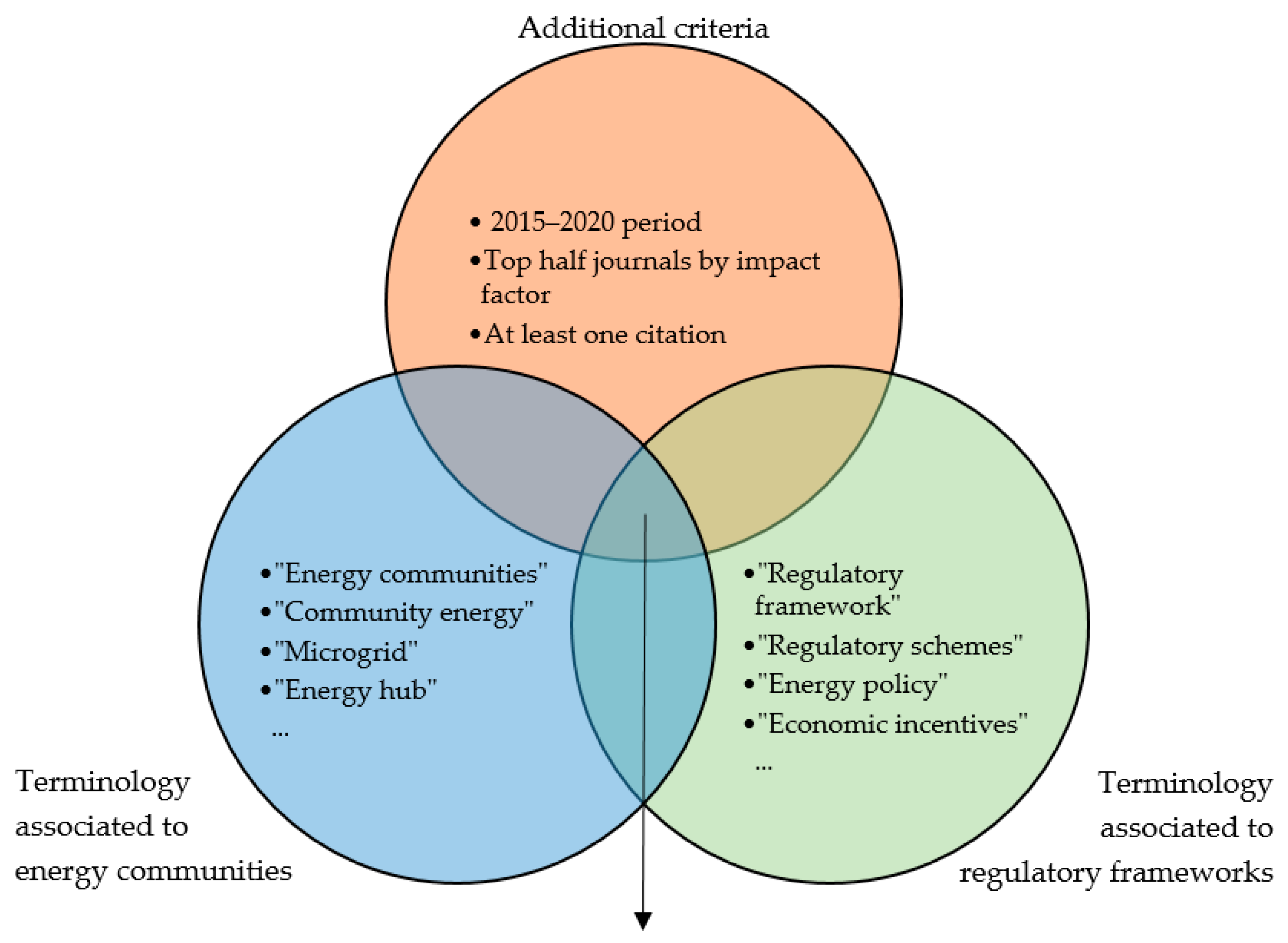

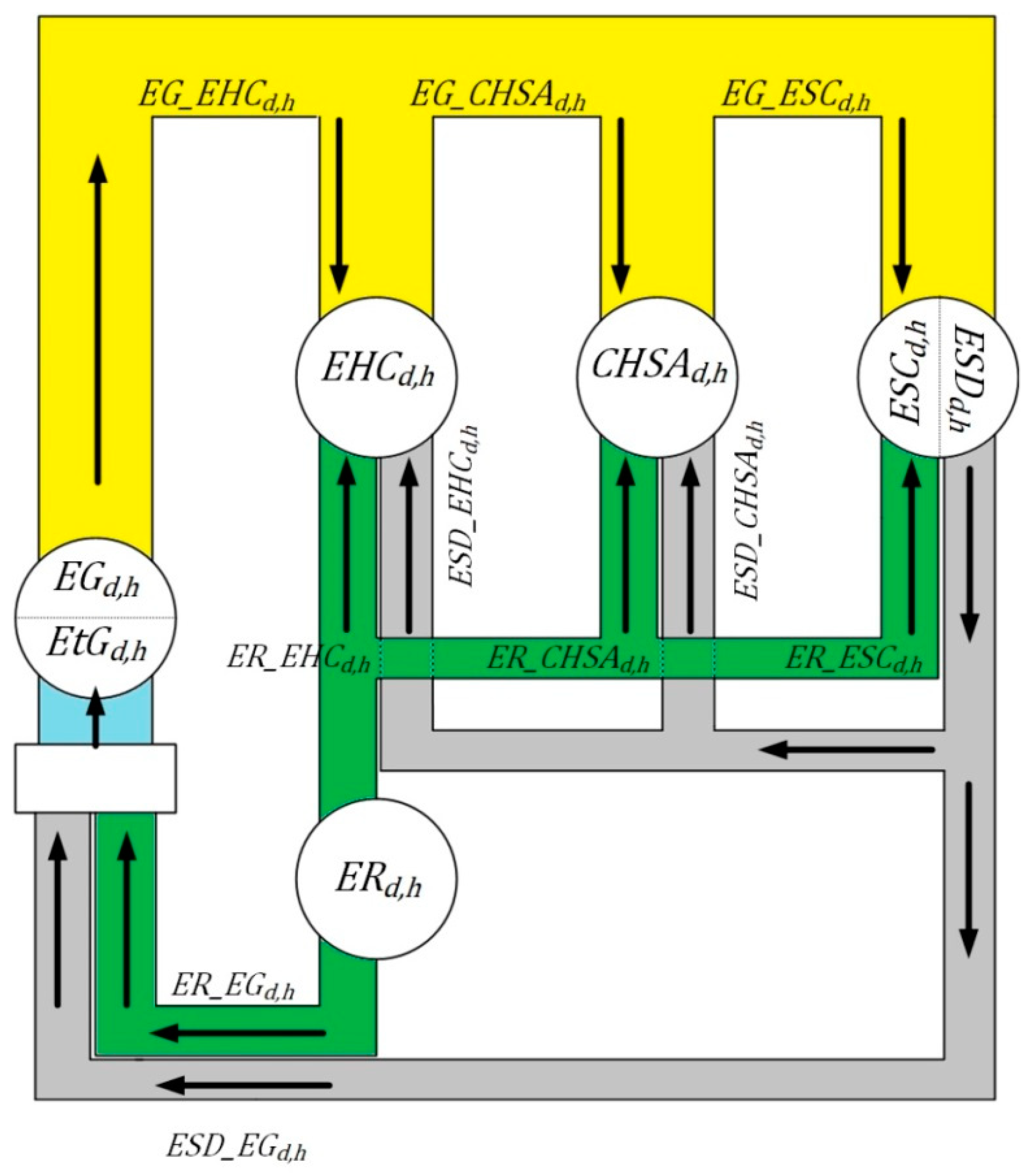
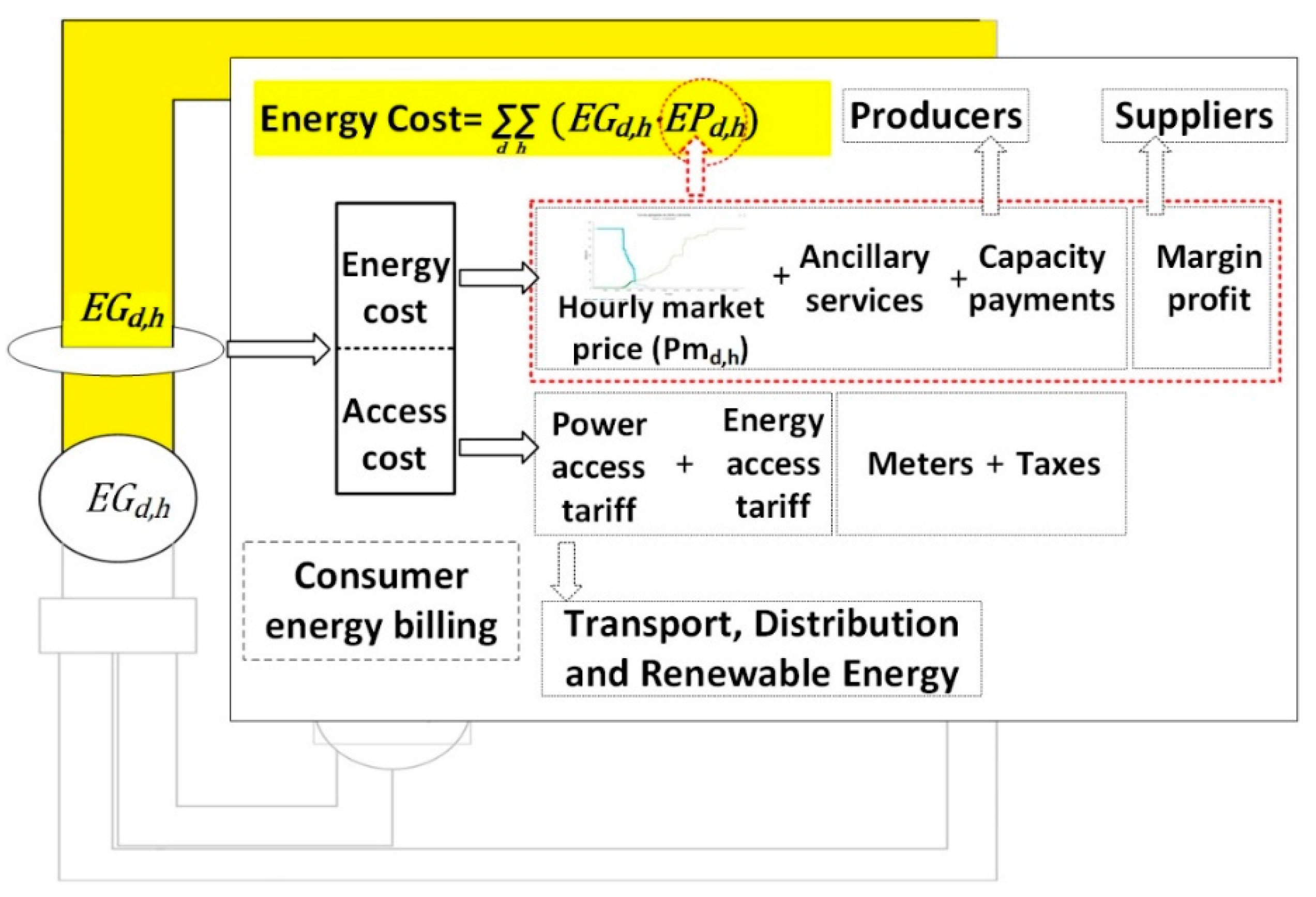
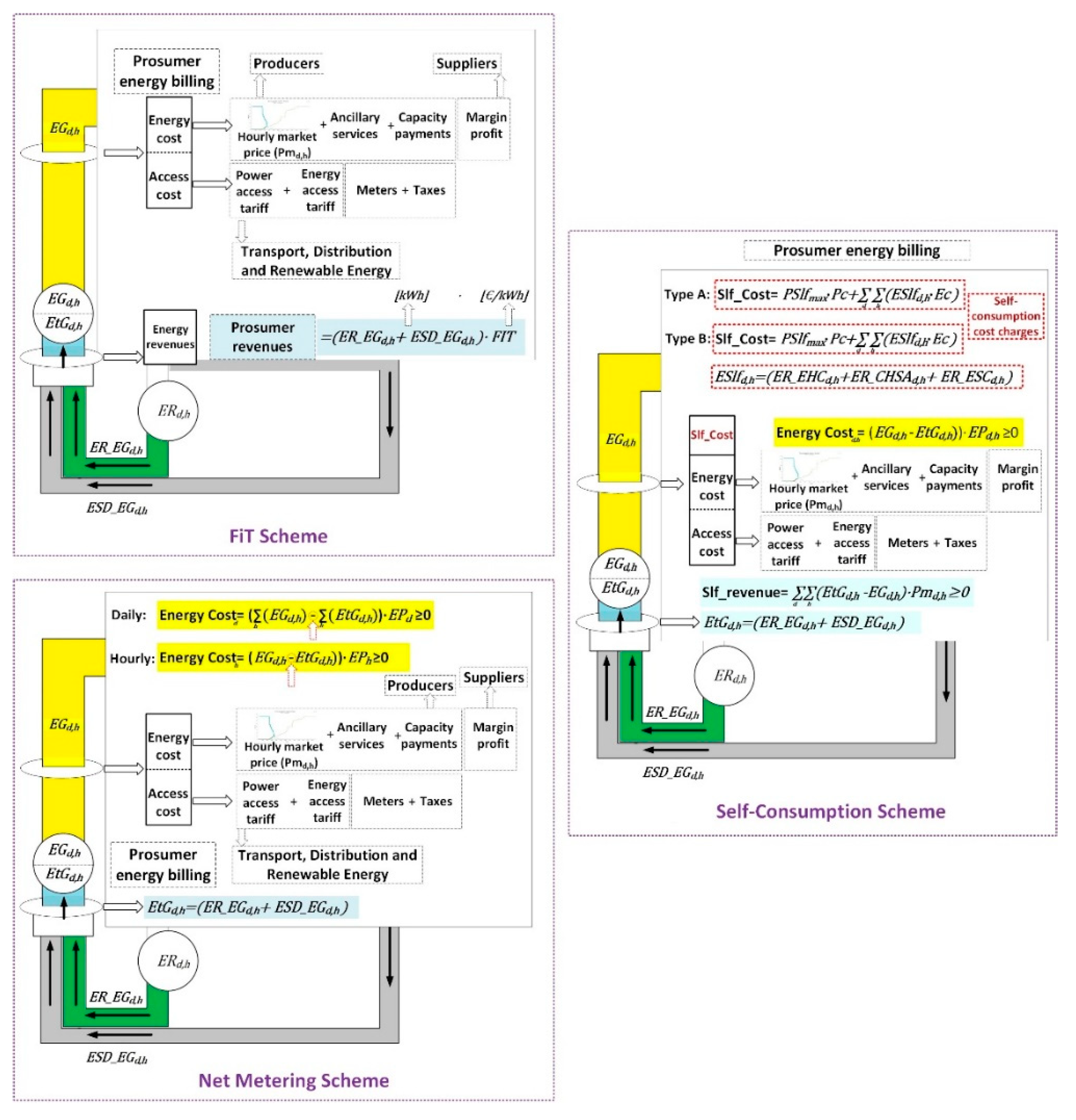


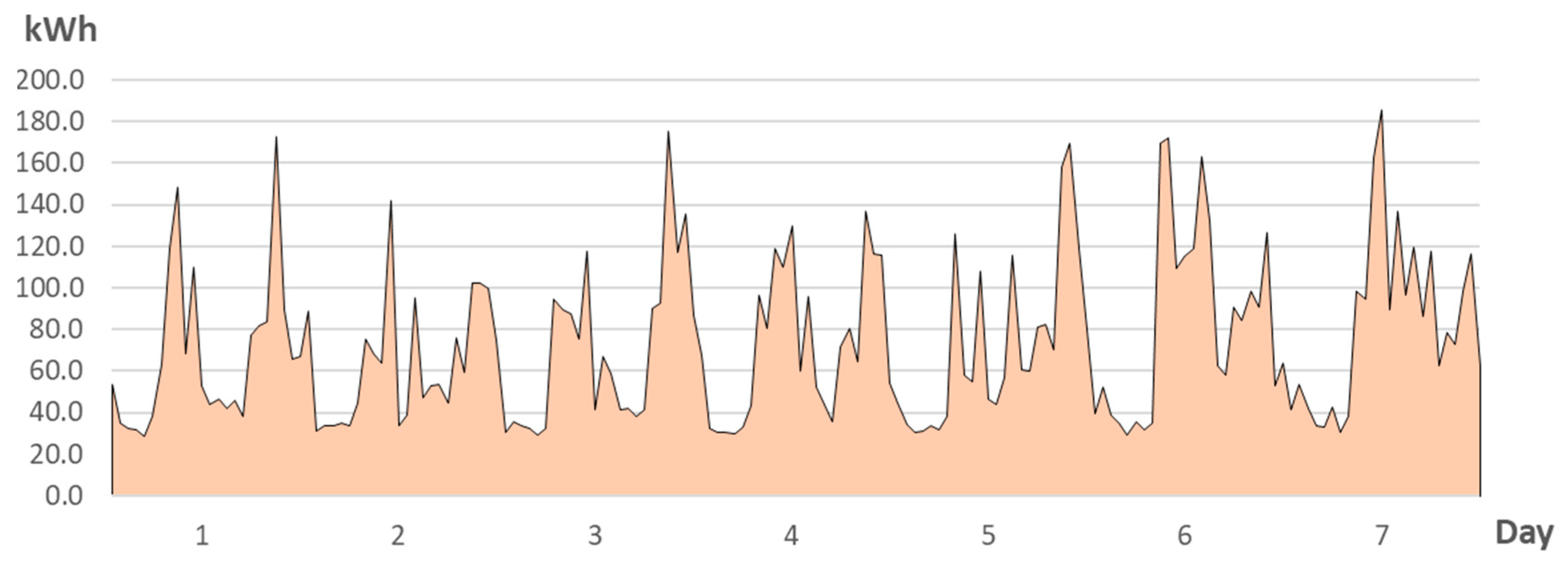
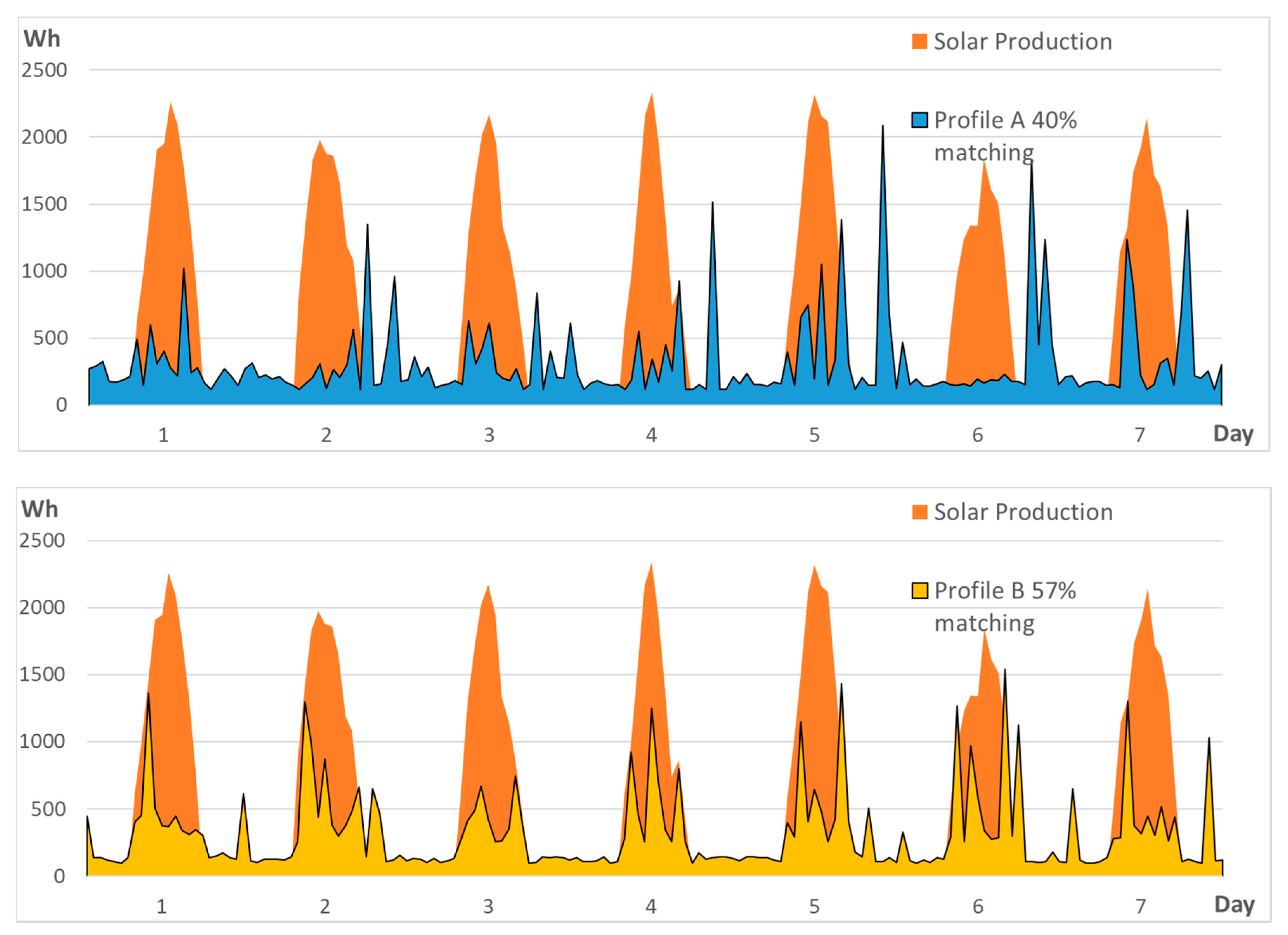
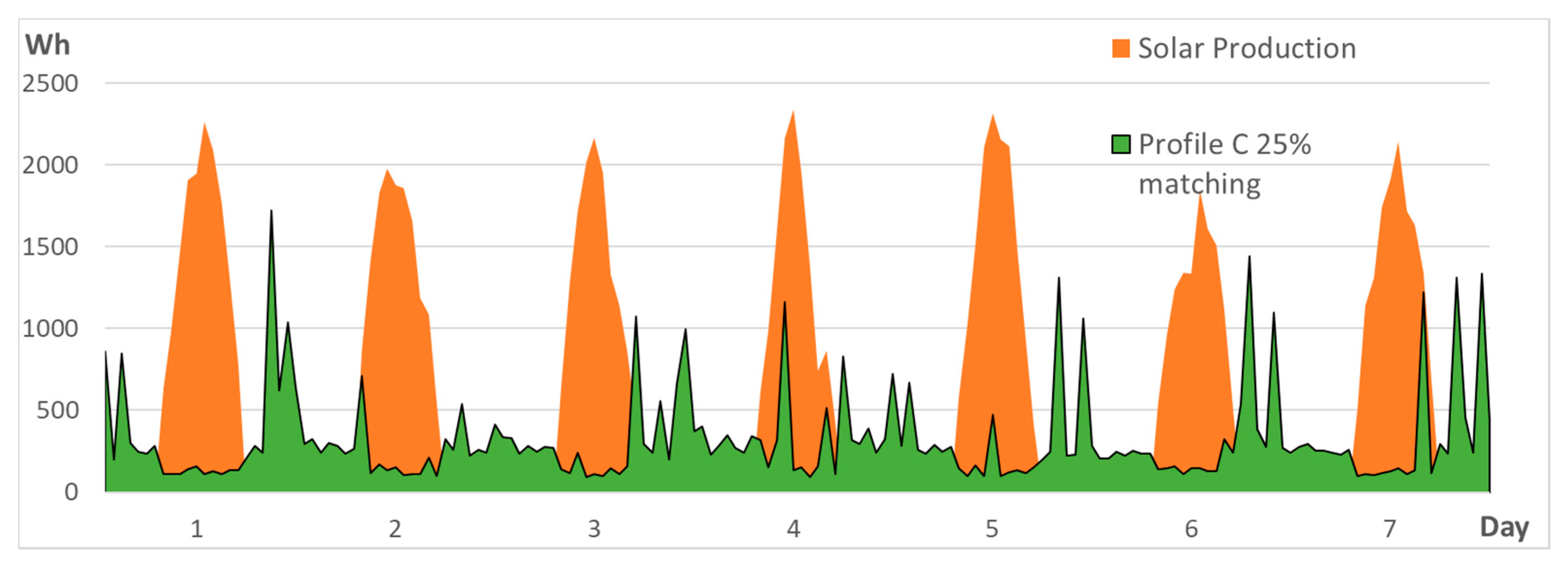


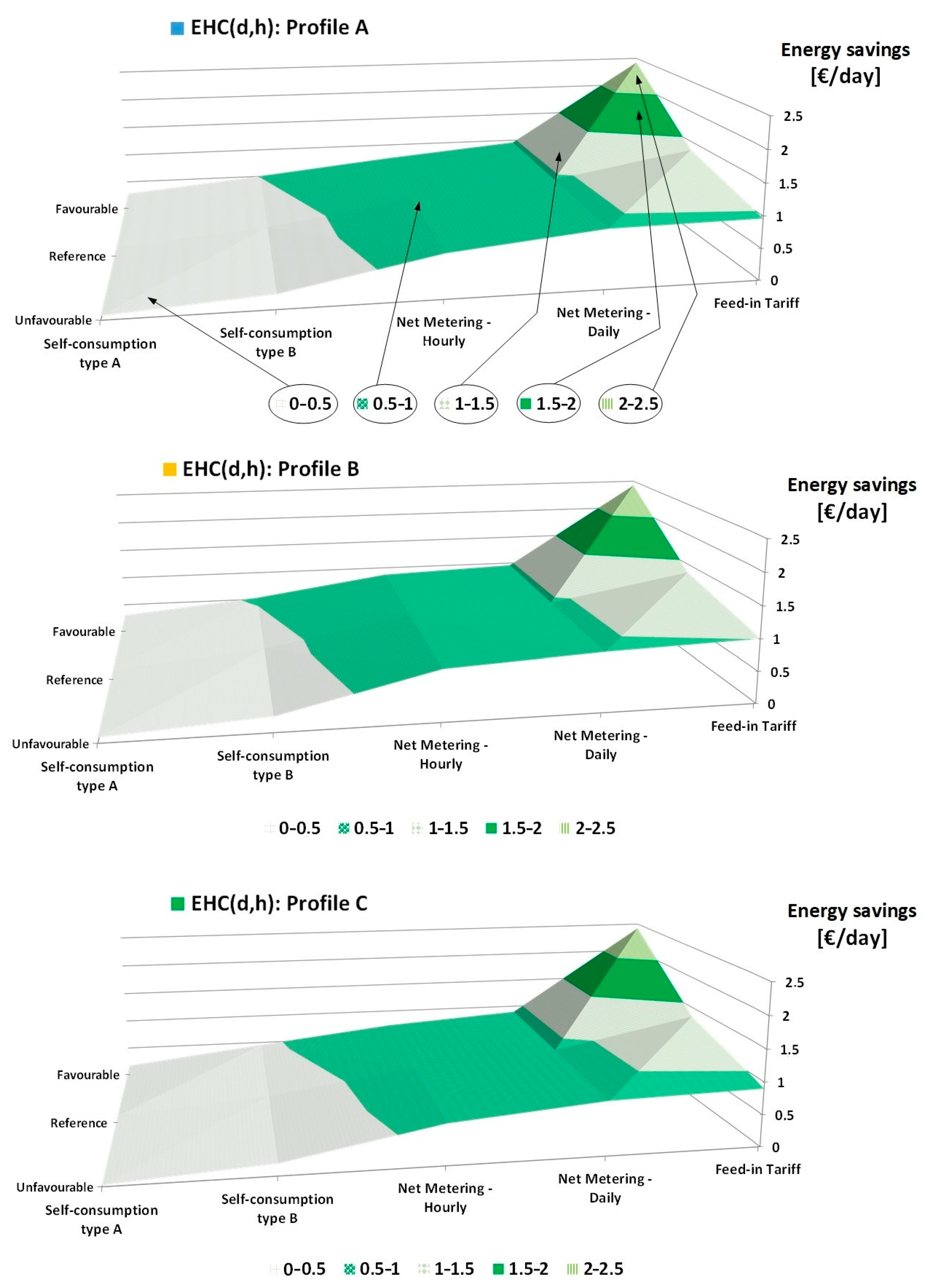

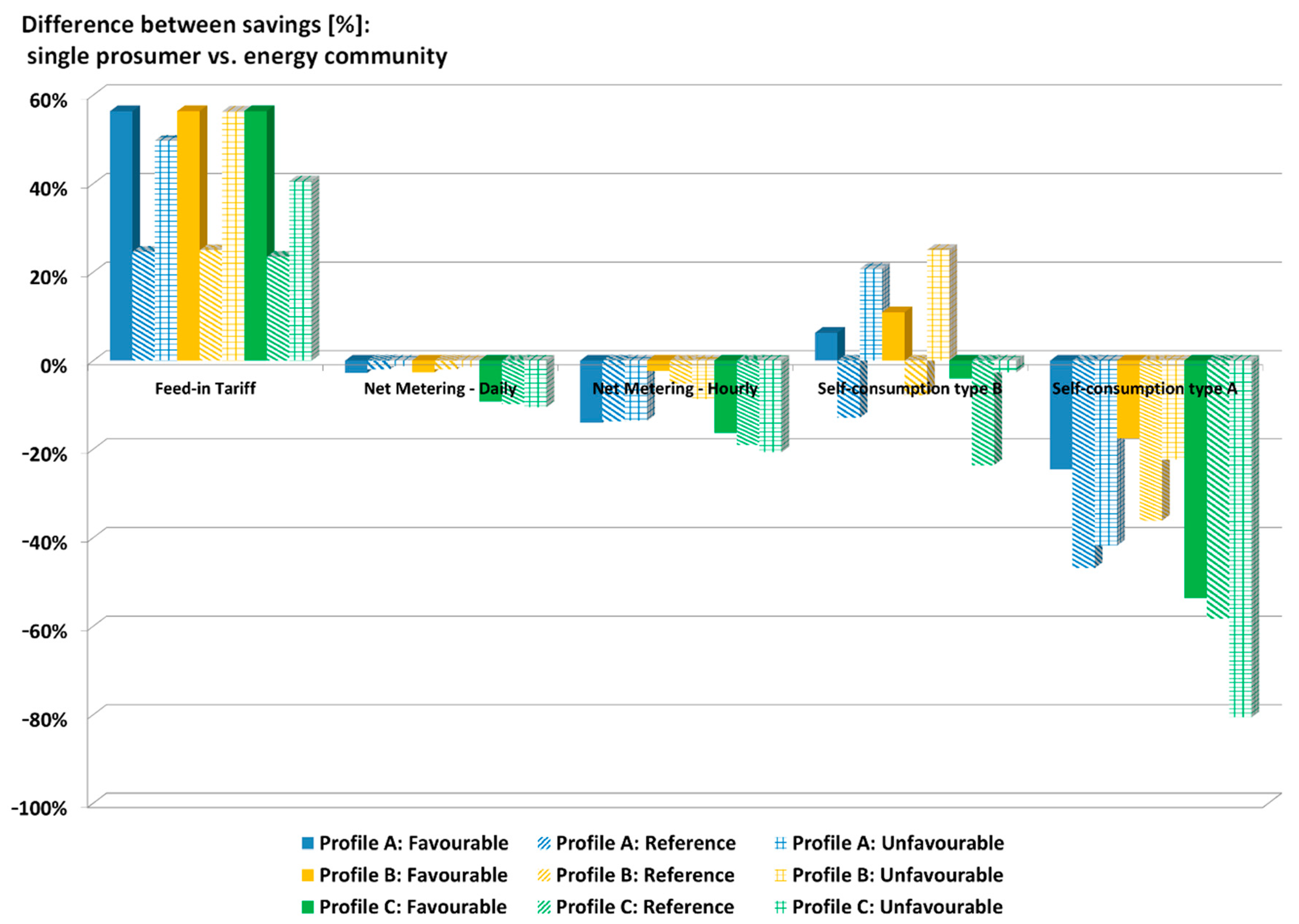

| Type of Supply Contract | Single Period (SP) |
|---|---|
| Access tariffs | p = 1 |
| Te [€/kWh] | 0.044 |
| Tp [€/kW·year] | 38.04 |
| Scenario | FiT Value |
|---|---|
| Favorable case | 0.18 €/kWh |
| Base case | 0.1315 €/kWh |
| Unfavorable case | 0.061 €/kWh |
| Scenario | Fixed Charge (€/kW·Year) | Variable Charge (€/kWh) |
|---|---|---|
| Favourable case | 6.515 | 0.034 |
| Base case | 8.144 | 0.043 |
| Unfavourable case | 9.773 | 0.052 |
| Parameter | Community Value | Individual Value | ||||
|---|---|---|---|---|---|---|
| Generation and Consumption | ||||||
| Time step | 1 h | |||||
| Simulation period | One week for each season (autumn, winter, spring and summer) | |||||
| Peak consumption | 200 kW | Base | Favorable | Unfavorable | ||
| 2.1 kW | 1.8 kW | 1.7 kW | ||||
| Hour of peak consumption | 21 h | 21 h | 10 h | 21 h | ||
| Average daily consumed energy | 1553 kWh | 9.8 kWh | 9.3 kWh | 9.0 kWh | ||
| Auxiliary services consumption | 1.7 kW | 10 W | ||||
| Contracted power | 381 kW | 2.3 kW | ||||
| Total PV capacity | 374 kW | 2.3 kW | ||||
| PV peak power | 302 kW | 1.9 kW | ||||
| Average daily generated energy | 1791 kWh | 11.9 kWh | ||||
| Energy storage | ||||||
| Battery capacity | 1275 kWh | 7.7 kWh | ||||
| Aggregated maximum charge/discharge power | 128 kW | 768 W | ||||
| Aggregated maximum charge/discharge power at status 1 | 25.5 kW | 154 W | ||||
| Efficiency | 98% | 98% | ||||
| Depth of discharge | 80% | 80% | ||||
| Initial State of Charge | 60% | 60% | ||||
| Electricity billing | ||||||
| Meter rent | 1.11 €/month | |||||
| VAT | 21% | |||||
| Electricity tax | 5.11% | |||||
| Electricity market price | 0.039–0.075 €/kWh | |||||
| Power term of the access tariff | 38.04 €/kW·year | |||||
| Energy term of the access tariff | 0.044 €/kWh | |||||
| FiT | Base | Favorable | Unfavorable | Base | Favorable | Unfavorable |
| 0.13 €/kWh | 0.18 €/kWh | 0.06 €/kWh | 0.13 €/kWh | 0.18 €/kWh | 0.06 €/kWh | |
| Net Metering | 1 to 1 | 1 to 1.2 | 1.2 to 1 | 1 to 1 | 1 to 1.2 | 1.2 to 1 |
| Self-consumption | Base charges | −20% charges | +20% charges | Base charges | −20% charges | +20% charges |
| O&M Costs | ||||||
| Energy sale tax | 0.5 €/MWh + 7% over the energy value | 0.5 €/MWh + 7% over the energy value | ||||
| PV O&M costs | 36.1 €/kW·year | 36.1 €/kW·year | ||||
| Storage O&M costs | 6.1 €/kW·year + 0.49 €/MWh | 6.1 €/kW·year + 0.49 €/MWh | ||||
| Regulatory Framework | Profile A | Profile B | Profile C | ||||||
|---|---|---|---|---|---|---|---|---|---|
| Fav. | Ref. | Unf. | Fav. | Ref. | Unf. | Fav. | Ref. | Unf. | |
| FiT | 0.19 | 0.14 | 0.05 | 0.19 | 0.15 | 0.15 | 0.19 | 0.12 | −0.06 |
| Net Metering–Hourly | −0.07 | −0.03 | 0.01 | 0.12 | 0.16 | 0.21 | −0.21 | −0.23 | −0.25 |
| Net Metering–Daily | −0.06 | −0.07 | −0.08 | 0.06 | 0.07 | 0.08 | −0.16 | −0.16 | −0.18 |
| Self-Consumption A | −0.25 | −0.22 | −0.14 | 0.12 | 0.05 | 0.09 | −0.44 | −0.39 | −0.29 |
| Self-Consumption B | 0.07 | 0.05 | 0.06 | 0.14 | 0.10 | 0.09 | 0.03 | −0.03 | 0.00 |
| Regulatory Framework | Profile A | Profile B | Profile C | ||||||
|---|---|---|---|---|---|---|---|---|---|
| Fav. | Ref. | Unf. | Fav. | Ref. | Unf. | Fav. | Ref. | Unf. | |
| FiT | 0.87 | 0.27 | 0.32 | 0.87 | 0.27 | 0.36 | 0.87 | 0.26 | 0.26 |
| Net Metering–Hourly | −0.12 | −0.11 | −0.11 | −0.02 | −0.04 | −0.07 | −0.14 | −0.16 | −0.17 |
| Net Metering–Daily | −0.03 | −0.02 | −0.01 | −0.03 | −0.02 | −0.01 | −0.09 | −0.09 | −0.10 |
| Self-Consumption A | −0.09 | −0.13 | −0.04 | −0.07 | −0.10 | −0.02 | −0.20 | −0.16 | −0.08 |
| Self-Consumption B | 0.03 | −0.05 | 0.04 | 0.05 | −0.03 | 0.05 | −0.02 | −0.10 | −0.01 |
Publisher’s Note: MDPI stays neutral with regard to jurisdictional claims in published maps and institutional affiliations. |
© 2021 by the authors. Licensee MDPI, Basel, Switzerland. This article is an open access article distributed under the terms and conditions of the Creative Commons Attribution (CC BY) license (http://creativecommons.org/licenses/by/4.0/).
Share and Cite
Alonso, À.; de la Hoz, J.; Martín, H.; Coronas, S.; Matas, J. Individual vs. Community: Economic Assessment of Energy Management Systems under Different Regulatory Frameworks. Energies 2021, 14, 676. https://doi.org/10.3390/en14030676
Alonso À, de la Hoz J, Martín H, Coronas S, Matas J. Individual vs. Community: Economic Assessment of Energy Management Systems under Different Regulatory Frameworks. Energies. 2021; 14(3):676. https://doi.org/10.3390/en14030676
Chicago/Turabian StyleAlonso, Àlex, Jordi de la Hoz, Helena Martín, Sergio Coronas, and José Matas. 2021. "Individual vs. Community: Economic Assessment of Energy Management Systems under Different Regulatory Frameworks" Energies 14, no. 3: 676. https://doi.org/10.3390/en14030676
APA StyleAlonso, À., de la Hoz, J., Martín, H., Coronas, S., & Matas, J. (2021). Individual vs. Community: Economic Assessment of Energy Management Systems under Different Regulatory Frameworks. Energies, 14(3), 676. https://doi.org/10.3390/en14030676







